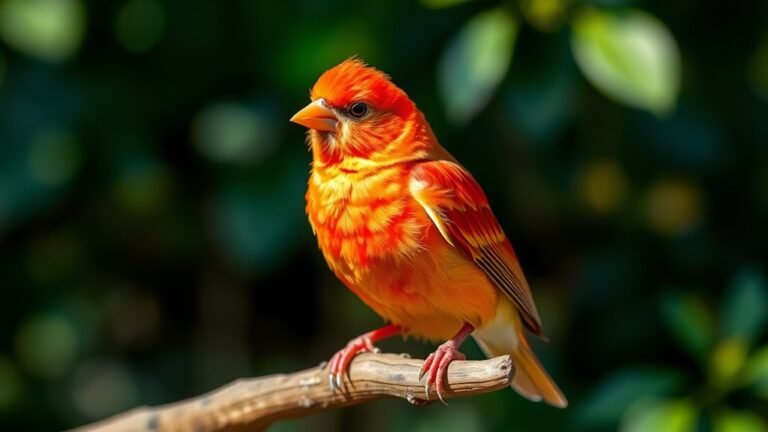The Alluring Black, Red, and White Bird Species
The Eurasian Magpie stands out with its striking black, white, and sometimes red feathers. This bird exhibits strong intelligence and has a unique social structure. Its cultural importance varies across communities, with many stories attached to its vivid appearance. Each encounter allows you to see the beauty and significance of this fascinating bird. What tales do its colors tell?
Key Takeaways
- The Eurasian Magpie is striking with its black and white feathers, renowned for its intelligence and social behavior.
- Scarlet Tanagers are visually captivating with their bright red feathers and are known for their beautiful songs in deciduous forests.
- Both species engage in significant social interactions and possess unique adaptations to their environments.
- The cultural significance of these birds varies, with magpies often symbolizing different omens in folklore.
- Their presence contributes to rich ecosystems, influencing insect populations and enhancing the connection with nature.
The Magnificent Red-Winged Blackbird

The Red-Winged Blackbird is known for its bright colors and loud calls, appealing to birdwatchers and nature lovers. These birds thrive in wetlands, choosing thick marsh plants to build their nests.
They adapt well to different environments, such as cattail areas and new wetlands.
During migration in spring and fall, Red-Winged Blackbirds travel in large, noisy groups. Watching their coordinated flight is a beautiful sight.
The Vibrant Scarlet Tanager
The Scarlet Tanager has bright red feathers and a beautiful song. It attracts birdwatchers in North America.
You can see these lively birds in deciduous forests, where they sing cheerful melodies. Their songs include a series of distinctive whistles that help them mark their territory and attract mates.
Scarlet Tanagers build their nests in high trees. They use twigs and plant fibers to create a strong structure.
Watching these stunning birds in nature can help you connect with the environment and foster a sense of community with other birdwatchers.
The Striking Eurasian Magpie

The Eurasian Magpie has striking black and white feathers that attract attention in Europe and Asia. These birds are intelligent and display many interesting behaviors. They hold cultural significance in different societies.
Here are some key points about them:
- They're playful and good at solving problems.
- They appear in folklore, representing both good and bad omens.
- They engage in social interactions and communication.
- They help control insect populations.
By learning about Eurasian Magpie behavior, you can understand their ecological role and deep ties to human culture.
Observing these birds helps highlight the beauty of nature and connects us to our shared environment.
The Enigmatic Indigo Bunting
You can often see the Indigo Bunting in green fields and forests. Its bright blue feathers attract attention.
This small songbird, known as Passerina cyanea, is beautiful and has interesting migration habits. In spring, male Indigo Buntings show off their blue colors to find mates, while females have a more subdued brown color.
As summer ends, these birds travel to Central America, flying hundreds of miles. Their sweet songs fill the air and connect us to nature.
Understanding the Indigo Bunting's role in its habitat shows the importance of protecting their environment. This makes you an important part of their story.
The Bold Red-Breasted Nuthatch

The Red-Breasted Nuthatch, or Sitta canadensis, is an eye-catching bird. Birdwatchers often enjoy its bright colors and lively behavior. This small bird uses bold foraging methods. It looks for insects under tree bark and can often be seen hanging upside down.
The Nuthatch also shows interesting nesting behavior. It makes holes in decaying trees to build secure homes.
Here are some key features of the Red-Breasted Nuthatch:
- Bright rusty-red underparts
- Agile climbing abilities
- Unique nasal calls
- Sociable behavior in flocks
These traits highlight the Nuthatch's lively personality. Observing this bird provides a sense of joy in nature.
Understanding the Red-Breasted Nuthatch reveals its strengths in resilience and adaptability in birds.
The Eye-Catching Black-capped Chickadee
The Black-capped Chickadee, or Poecile atricapillus, is a delightful bird found in North America's woodlands. Its black cap and bib stand out against its white cheeks, making it easy to recognize.
Chickadees often join mixed-species flocks to find food. You can see them moving quickly between trees in different places, like deciduous forests and suburban parks. They call out with their cheerful "chick-a-dee-dee-dee" song, which helps warn others about potential dangers.
In winter, these birds cache food to prepare for tough times. Their ability to adapt and thrive enriches our natural environment, allowing us to connect with the beauty of birds.
The Charismatic Rose-breasted Grosbeak
The Rose-breasted Grosbeak, known scientifically as Pheucticus ludovicianus, is striking with its pink and black plumage.
This bird easily attracts attention in North American gardens and woodlands. Its vibrant colors and unique songs make it a delight to observe.
This grosbeak prefers various habitats, including dense forests and suburban areas, making it easy to spot.
Here are some key behaviors of the Rose-breasted Grosbeak:
- Males sing to attract mates.
- They build cup-shaped nests in trees.
- Their diet mainly includes seeds, fruits, and insects.
- They often forage in pairs or small groups.
Observing the Rose-breasted Grosbeak enriches your connection to nature.
Appreciating this beautiful bird and its habitats adds joy to your outdoor experiences.
The Dazzling Barn Swallow
Barn Swallows (Hirundo rustica) are often seen flying over fields and coastlines. Their blue feathers shine in the sunlight, and their forked tails create a striking appearance.
These birds are skilled fliers, catching insects in mid-air. In summer, they adapt to different areas, from farms to cities, and build mud nests under eaves and bridges.
You can hear their cheerful chirping as they gather in flocks, showing their social nature. During migration, they travel together, forming strong connections with others.
Watching these swallows can enhance your appreciation of nature's beauty and the relationships formed in shared spaces.
The Unique California Quail
The California quail (Callipepla californica) has a plump body and a patterned coat of browns, grays, and chestnut. These birds thrive in various California habitats, including chaparral and open grasslands. Observing their behavior can be quite enjoyable.
- California quail are social and form coveys.
- They forage by scratching the ground for seeds and insects.
- They've unique calls that echo across their territory.
- They're excellent runners and escape swiftly from predators.
Learning about California quail behavior helps you connect with them. You'll appreciate their beauty and their important role in the ecosystem.
Frequently Asked Questions
What Specific Habitats Do These Bird Species Prefer?
These birds thrive in various habitats. They prefer lush wetland ecosystems for nesting and feeding. Additionally, they like dense forest areas, where their bright colors blend well with the surrounding greenery. Such diverse environments support their survival and behavior, making them fascinating creatures to observe.
How Can I Attract These Birds to My Backyard?
To attract these beautiful birds to your backyard, follow these simple steps:
- Set up a variety of bird feeders filled with seeds they prefer.
- Install nesting boxes nearby to provide safe places for them to stay.
- Create a welcoming environment by adding plants and water sources.
What Is the Lifespan of These Bird Species?
The lifespan of birds can differ widely due to factors like their habitat, diet, and threats from predators. Typically, birds live from a few years to over a decade, depending on their living conditions.
Do Any of These Birds Migrate Seasonally?
Yes, these birds migrate seasonally. Their migration patterns change with the seasons. When temperatures drop, they move to warmer areas. This behavior shows their ability to adapt and find suitable homes throughout the year.
What Are the Main Threats to Their Populations?
The main threats to their populations are habitat destruction and climate change. Habitat destruction occurs when areas where these birds live are damaged or removed. Climate change affects their environment, making it harder for them to find food and shelter. You can help by supporting conservation efforts. These efforts protect their homes and help ensure these beautiful birds continue to thrive. Together, we can maintain the biodiversity that connects all living things.

Hello, I’m Amelia White, the founder of birdsfanatic.com. As a lifelong bird enthusiast and spiritual seeker, I’ve always been fascinated by the mystical connections between birds and the human experience. On this site, I share my knowledge and insights into the symbolic meanings and spiritual significance of various bird species, exploring their roles in mythology, folklore, and cultural traditions. Join me on this journey into the world of birds, where we’ll discover the hidden wisdom and guidance that these magnificent creatures have to offer.







